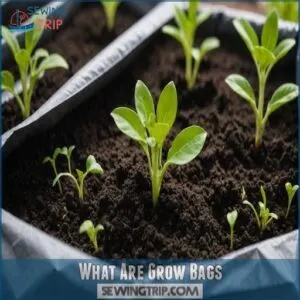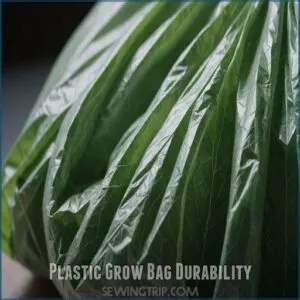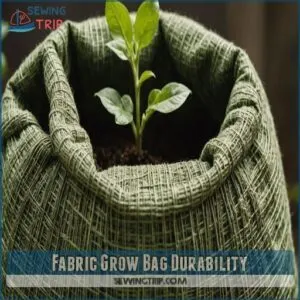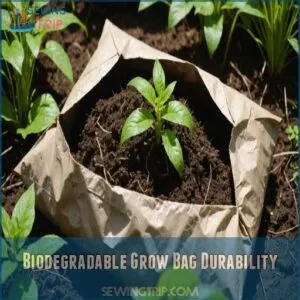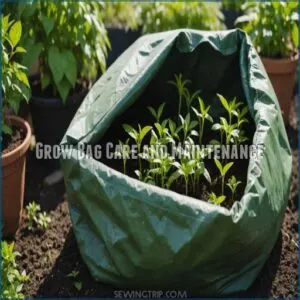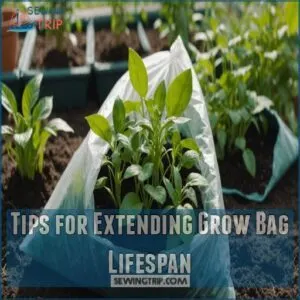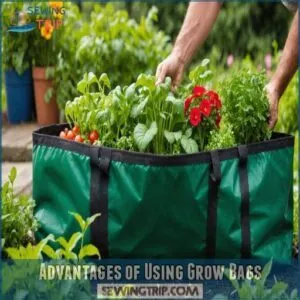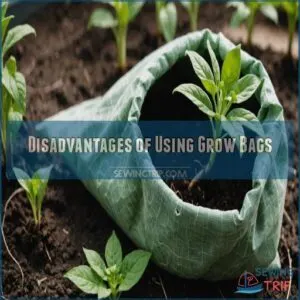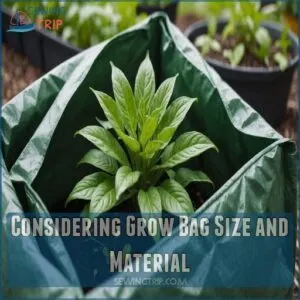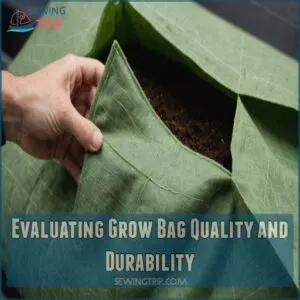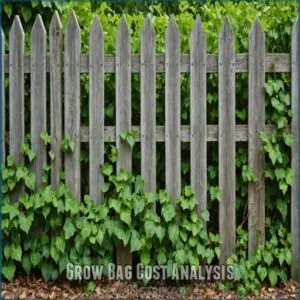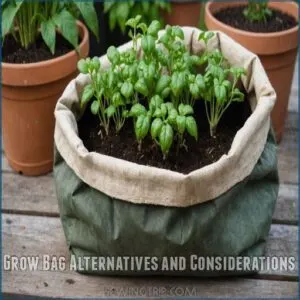This site is supported by our readers. We may earn a commission, at no cost to you, if you purchase through links.
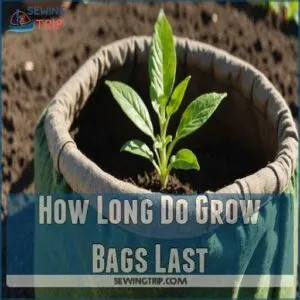
The lifespan depends on material quality, sun exposure, and how you handle them.
Plastic grow bags usually last just one season, while heavy-duty fabric bags made from nonwoven polypropylene offer better durability.
You’ll notice wear when the fabric starts thinning or developing tears.
While they don’t match ceramic pots’ longevity, grow bags give you the flexibility to experiment with different plants and layouts.
The secret to maximizing their lifespan lies in some surprisingly simple maintenance tricks.
Table Of Contents
- Key Takeaways
- What Are Grow Bags
- How Long Do Grow Bags Last
- Grow Bag Materials and Durability
- Grow Bag Care and Maintenance
- Tips for Extending Grow Bag Lifespan
- Advantages of Using Grow Bags
- Disadvantages of Using Grow Bags
- Choosing The Right Grow Bag for Your Needs
- Grow Bag Cost Analysis
- Grow Bag Alternatives and Considerations
- Frequently Asked Questions (FAQs)
- Conclusion
Key Takeaways
- You’ll get 2-3 growing seasons from standard fabric grow bags, while premium ones can last up to 5 years when properly maintained.
- Your grow bag’s lifespan depends heavily on material type – plastic ones typically last 3-5 years, fabric options 2-3 seasons, and biodegradable versions just one growing cycle.
- You can extend your grow bags’ life by storing them in cool, dry places, cleaning between seasons, and avoiding direct sunlight exposure.
- You’ll need to weigh the shorter lifespan against benefits like better root health through air pruning, improved drainage, and portability when deciding if grow bags are right for you.
What Are Grow Bags
You’ll find grow bags are portable containers made from breathable materials like fabric or plastic that give your plants a healthy home for their roots.
These lightweight alternatives to traditional pots help your plants thrive with better air circulation and drainage, while saving you precious garden space.
Types of Grow Bags
When choosing grow bags, you’ll typically find two main types: plastic and fabric.
Plastic grow bags, like those from Vivosun and Gro Pro, excel at moisture retention but offer less breathability.
Fabric options, including Smart Pot and Hydrofarm, are made from thick, non-woven materials that promote better aeration.
You’ll also find biodegradable bags, which decompose naturally but have a shorter lifespan than their synthetic counterparts.
Benefits of Using Grow Bags
With grow bags, you’ll discover a world of gardening freedom that traditional pots can’t match.
These versatile containers save precious space on your patio or balcony while offering superior drainage.
You’ll love how easy they’re to transport when rearranging your garden.
Plus, their breathable fabric promotes healthier root systems, making them perfect for both beginners and experienced gardeners alike.
How Grow Bags Work
Growing bags work through a simple yet clever system.
The fabric or plastic material promotes natural air pruning – your plant’s roots stop growing when they reach the side walls instead of circling.
This creates a dense, healthy root system that maximizes nutrient uptake.
Plus, the porous nature of grow bags provides excellent drainage and prevents waterlogged soil, giving your plants the perfect balance of moisture and oxygen.
How Long Do Grow Bags Last
You’ll find that grow bags can last anywhere from 1 to 10 years, depending on the materials they’re made from and how well you care for them.
While cardboard grow bags might only last a single season, high-quality fabric or plastic ones can serve you well for five years or more with proper maintenance.
Factors Affecting Grow Bag Lifespan
Several key factors determine how long your grow bags will serve you well.
Understanding these elements helps you maintain control over your garden’s success.
Here’s what impacts your grow bags’ durability:
- Direct sun exposure can weaken fabric fibers over time
- Harsh soil types might cause faster wear and tear
- Improper watering habits lead to mold and deterioration
- Poor storage conditions accelerate material breakdown
By managing these factors properly, you’ll extend your grow bags’ useful life considerably.
Average Lifespan of Different Grow Bag Materials
Most grow bags have distinct lifespans based on their materials.
Plastic varieties typically last 3-5 years with proper care, while heavy-duty fabric bags can stretch to 5-7 years.
Premium fabric grow bags, though pricier, often reach the 7-10 year mark when maintained correctly.
Biodegradable options naturally decompose within 1-2 seasons, and cardboard versions usually survive one growing cycle.
Grow Bag Materials and Durability
You’ll find that grow bags come in three main types: plastic, fabric, and biodegradable materials, each with its own durability rating and unique benefits.
With proper care, you can expect your plastic grow bags to last up to 5 years, while fabric options typically serve you well for 2-3 growing seasons, and biodegradable versions naturally break down after about a year.
Plastic Grow Bag Durability
Plastic grow bags stand up against harsh conditions thanks to their sturdy construction and UV-resistant materials.
You’ll typically get 3-5 years of use from high-quality options with proper thickness and tear strength.
While they’re not as breathable as fabric alternatives, they excel at moisture retention and chemical resistance.
For best results, look for bags with reinforced seams and UV-stabilized materials that won’t break down in sunlight.
Fabric Grow Bag Durability
Made from thick, non-woven polypropylene, fabric grow bags typically last 3-5 years with proper care.
Their durability depends on factors like UV resistance, tear strength, and weight capacity.
You’ll find they’re more resilient than you might expect, thanks to their tight fabric weave that balances water retention and drainage.
Regular cleaning and avoiding direct sunlight can considerably extend their lifespan.
Biodegradable Grow Bag Durability
While fabric grow bags made from sustainable materials like natural sustainable fabrics such as organic cotton, hemp, and bamboo lyocell can make a positive impact, fabric grow bags offer excellent durability, biodegradable options present an eco-friendly choice with a shorter lifespan.
These environmentally conscious alternatives typically last 1-2 growing seasons before naturally breaking down during composting.
You’ll notice gradual decomposition as the material returns to the earth, especially when comparing it to synthetic fabrics like polyester production which contributes to microplastic pollution, making them perfect for gardeners passionate about reducing their environmental impact.
Despite their limited lifespan, they’re ideal for seasonal crops and experimental gardens.
Grow Bag Care and Maintenance
You’ll get more growing seasons from your grow bags when you know how to properly clean, store, and repair them.
By following a few simple maintenance steps, you can extend their life from a single season to several years of productive gardening.
Moving Grow Bags
Properly moving your grow bags helps maintain their durability for seasons to come.
Here’s how to protect your investment when relocating:
- Place a flat piece of wood or plastic under larger bags to prevent tears
- Use a sturdy dolly for bags over 20 gallons
- Lift from the bottom instead of using handles, which can weaken over time
Remember: a full grow bag weighs considerably more than you might expect, so recruit a helping hand for the heavy lifters.
Cleaning Grow Bags
Keeping your grow bags clean is like giving them a spa day – it boosts their lifespan and keeps your plants healthy.
To maintain your grow bags’ material and prevent damage, consider applying tips from general fabric care, such as adjusting heat settings and using a steam iron for wrinkle removal.
Here’s your simple cleaning guide:
| Step | Action | Tips |
|---|---|---|
| 1 | Rinse | Use a garden hose to blast away dirt |
| 2 | Soak | Mix warm water with baking soda |
| 3 | Sanitize | Add white vinegar for natural disinfection |
You’ll want to clean between growing seasons, and anytime you notice salt buildup or funky smells.
Storing Grow Bags
You’ll want to give your grow bags a thorough cleaning before storing them away for the season.
Once they’re clean and completely dry, fold them neatly to save precious storage space.
A cool, dry spot away from direct sunlight works best – think garage shelves or basement storage containers.
Smart storage prevents premature wear and keeps your bags ready for next season’s planting adventures.
Repairing Grow Bags
A grow bag‘s small tear doesn’t mean it’s destined for the trash.
With basic repair skills, you can patch holes and extend your bag’s life considerably.
Here’s what experienced gardeners use to mend their bags:
- Heavy-duty thread and a sturdy needle for stitching tears
- Fabric patches cut from old grow bags
- Waterproof fabric adhesive for reinforcement
- UV-resistant repair tape for quick fixes
- Mesh patches for maintaining breathability
The key is matching your repair material to your bag’s fabric type and ensuring repairs are watertight.
Tips for Extending Grow Bag Lifespan
You’ll be surprised how long your grow bags can last with the right care and attention to detail.
By following these practical tips for proper handling, cleaning, and storage, you can extend your grow bags’ life from just one season to several years of successful gardening.
Proper Handling and Storage
Smart handling and storage practices add years to your grow bags’ life.
Let’s break down exactly what works to keep them in top shape, whether you’re moving them around or tucking them away for the season.
To keep other items, like your fabric stash, organized and protected, consider utilizing fabric storage bags.
| Activity | Do This | Not That |
|---|---|---|
| Moving | Use a dolly or cart | Drag across ground |
| Storage | Cool, dry space | Direct sunlight |
| Protection | Support bottom | Stack heavily |
| Handling | Lift with care | Pull by handles |
Regular Cleaning and Maintenance
Regular maintenance doubles your grow bags’ lifespan and keeps your plants thriving.
Start with a monthly cleaning routine – gently brush off dirt, inspect for damage, and remove any salt deposits.
Between growing seasons, wash bags thoroughly with mild soap and water, then air dry completely.
Store clean bags away from moisture and pests.
A well-maintained grow bag rewards you with years of reliable gardening.
Avoiding Extreme Temperatures
Along with proper care, protecting your grow bags from temperature extremes is very important for longevity.
Keep them out of direct sunlight during peak summer hours to prevent UV damage and material breakdown.
In winter, store bags in a climate-controlled space or garage to avoid frost damage.
If you’re growing year-round, consider using shade cloth during heat waves and frost protection during cold snaps.
Advantages of Using Grow Bags
You’ll find grow bags are a game-changer for your garden, offering exceptional root health through air pruning while saving precious space in small areas.
Grow bags are versatile containers that let you grow healthy plants anywhere, from apartment balconies to areas with poor soil quality.
You can easily move them around as needed.
Space-Saving and Portable
Living in a tight spot doesn’t mean giving up your garden dreams.
Grow bags fit perfectly in small spaces, from snug balconies to cozy patios.
You’ll love how these lightweight planters fold flat when not in use, saving precious storage space during off-seasons.
With the right maintenance, you can extend your grow bag lifespan check.
Need to chase the sun or rearrange your urban farm? Simply pick up your portable garden and move it wherever you need – no heavy lifting required.
Improved Soil Aeration and Drainage
The remarkable thing about grow bags is how they manage airflow and water like a pro.
While their portability is great, you’ll love how these bags prevent soil compaction through their breathable fabric.
Water flows freely through the porous material, eliminating drainage problems that plague traditional pots.
Think of it as giving your soil a perfect balance of moisture and air – not too wet, not too dry.
Healthier Root Growth
Growing healthy roots becomes effortless with grow bags, thanks to their unique air pruning feature.
When roots reach the bag’s porous walls, they naturally self-prune instead of circling like in traditional pots.
This prevents rootbound issues and encourages robust root branching throughout the soil.
You’ll notice stronger, more vigorous plants as the enhanced root system efficiently absorbs nutrients and water, leading to better overall growth.
Disadvantages of Using Grow Bags
While grow bags offer many benefits for your garden, you’ll want to weigh some drawbacks before making your purchase.
You’ll need to replace them more often than traditional pots, and you’ll find yourself watering more frequently due to their quick-draining nature.
Limited Lifespan
Most grow bags won’t stick around forever like traditional pots do.
While plastic varieties might last 3-5 years, fabric options typically need replacing after 2-3 growing seasons.
Even with proper care, you’ll notice wear and tear from UV exposure, soil pressure, and frequent watering.
Biodegradable options naturally decompose faster, usually lasting just one season before showing significant breakdown.
Higher Cost
Beyond their shorter lifespan, you’ll need to factor in the ongoing costs of using grow bags.
While a single five-gallon bag might set you back around $6, replacing them every few seasons adds up quickly compared to traditional pots.
This is why some gardeners opt to repurpose old materials, much like savvy sewers use thrift stores for affordable fabric and sewing supplies, sewing on a budget.
Budget-friendly alternatives include repurposing materials or exploring DIY solutions, but quality grow bags from reputable manufacturers offer reliable performance that often justifies their price tag.
Increased Water Consumption
The porous fabric of grow bags means you’ll need to water more frequently than traditional containers.
While this improved drainage prevents root rot, it also leads to faster evaporation and increased water consumption.
You might find yourself watering twice daily during hot spells, especially with moisture-loving plants.
To combat this, consider adding water-retaining soil amendments or setting up an automated drip system for more efficient water management.
Choosing The Right Grow Bag for Your Needs
You’ll want to think about both size and material type when selecting a grow bag that fits your gardening needs and budget.
Whether you choose a fabric bag that lasts 5+ years or a budget-friendly plastic option, you’ll need to weigh factors like durability, water retention, and root health to make the best choice for your plants.
Considering Grow Bag Size and Material
While every gardener faces unique space and planting needs, picking the right grow bag size and material makes all the difference.
Here’s what you’ll want to keep in mind:
- Start with 5-gallon bags for single tomato or pepper plants
- Choose 10-15 gallon bags for multiple plants or larger varieties
- Select fabric bags for better aeration, or plastic for longer-term durability
Remember, you’re not just buying a container – you’re investing in your plants’ future home.
Evaluating Grow Bag Quality and Durability
Once you’ve selected your ideal size, checking quality details makes all the difference.
Look for thick, double-stitched seams that won’t split under pressure.
UV-resistant fabric prevents sun damage, while reinforced handles support heavy lifting.
Opting for fabric with Sunbrella-like durability can greatly extend the life of your grow bags.
Squeeze the material – it should feel sturdy but flexible.
Premium bags often use 300GSM or higher fabric density, ensuring they’ll withstand multiple growing seasons and regular handling.
Grow Bag Cost Analysis
You’ll need to weigh both the initial price and replacement costs when you’re shopping for grow bags, since a $6 five-gallon bag might seem cheap until you factor in replacing it every few years.
To help you make a smart choice for your garden and wallet, let’s examine how grow bag costs stack up against traditional containers and explore ways to maximize your investment.
Initial Cost Vs. Long-Term Cost
Looking at grow bags as a long-term investment helps you make smarter gardening decisions.
The initial price tag might seem steep, but considering their lifespan and benefits paints a clearer picture of their true cost.
Investing in high-quality options, such as best grow bags, can greatly extend their lifespan.
Here’s what impacts your long-term costs:
- Quality materials add years to your bag’s life
- Proper maintenance reduces replacement frequency
- Bulk purchases often lower per-unit costs
- Seasonal care extends usability beyond average lifespans
Your actual costs depend heavily on how well you maintain your grow bags.
Smart care routines can greatly stretch your investment, making that upfront cost more worthwhile.
Comparing Grow Bag Costs to Other Containers
Beyond initial costs, you’ll want to compare grow bags with traditional containers to get the best value.
Here’s a practical breakdown of what you’re looking at:
| Container Type | 5-Gallon Cost | Lifespan (Years) | Total Cost/Year |
|---|---|---|---|
| Grow Bags | $6-10 | 2-3 | $2-5 |
| Ceramic Pots | $25-40 | 10+ | $2.50-4 |
| Plastic Pots | $8-15 | 3-5 | $2-5 |
Consider these numbers as you weigh your options – they might surprise you.
Grow Bag Alternatives and Considerations
If you’re looking for alternatives to grow bags, you’ll find plenty of options from traditional clay pots to innovative hydroponic systems that can match your gardening needs.
You’ll want to weigh factors like durability, cost, and plant requirements when choosing between these alternatives, as each option comes with its own set of advantages for different growing situations.
Traditional Pots and Containers
Traditional pots come with their own set of advantages.
While they’re more expensive upfront than grow bags, ceramic and plastic containers, such as those found in plastic pot options, often last 10+ years with proper care.
Consider your potting soil needs – these containers typically require less frequent watering due to better moisture retention.
Just make sure you’ve got good drainage holes and the right container size for your plants.
Bonus points for their classic aesthetic appeal and material durability.
Other Types of Grow Bags and Systems
Modern gardening offers exciting alternatives like raised beds with built-in wicking systems, which combine the benefits of grow bags with automated watering.
If you’re looking for durable gardening options, consider incorporating materials like polyester, which is known for its wear and tear resistance to damage.
You’ll also find innovative setups like aeroponics and hydroponics that ditch soil entirely.
For tech-savvy gardeners, aquaponics systems pair plant growing with fish farming.
These options let you customize your growing setup while maintaining the space-saving advantages you’ve come to expect from container gardening.
Frequently Asked Questions (FAQs)
How long do plastic grow bags last?
You’d think plastic grow bags would last forever, right?
Well, while they’re not immortal, you can expect your plastic grow bags to serve you faithfully for 5-10 years with proper care and maintenance.
How long do fabric grow bags last?
Fabric grow bags typically last 3-5 years with proper care.
Cleaning, storing them properly between seasons, and avoiding rough handling that could damage the material will help extend their life.
Should I buy a grow bag?
Thinking of starting a garden but short on space?
Grow bags are a smart choice if you’re renting, need mobility, or want better root development.
They’re cost-effective and versatile, though they’ll need replacing every few years.
How do I prolong the lifespan of my grow bags?
Keep your grow bags lasting longer by cleaning between seasons, storing in dry places, avoiding direct sunlight, and repairing holes promptly.
Don’t drag them across surfaces – use a dolly when moving heavy bags.
What is the lifespan of a grow bag?
Your grow bag’s lifespan varies by material: cardboard lasts 1 year, while plastic or fabric bags can serve you 5-10 years with proper care.
Premium materials and regular maintenance will maximize their durability.
What is the downside of grow bags?
While 80% of gardeners praise grow bags’ portability, they do have drawbacks. You’ll need to water more frequently, replace them every few years, and they’re not as attractive as traditional pots.
Are grow bags worth the money?
Grow bags deliver excellent value with their flexibility and plant-friendly design.
They’re cost-effective at $6 for a 5-gallon size, plus they’ll boost root health and adapt to any space.
Consider them a smart gardening investment.
How many times can you reuse a grow bag?
Despite concerns about durability, fabric grow bags can be reused 3-5 times with proper care.
You’ll extend their life by cleaning between seasons, avoiding rough handling, and storing them dry in a cool place.
Can you stack grow bags on top of each other?
Stacking grow bags isn’t recommended.
It can crush plants and roots, block drainage, and limit air circulation.
If you’re short on space, use vertical gardening systems or shelving units instead.
Do grow bags attract pests more than regular containers?
Your fabric grow bags won’t attract more pests than traditional containers.
The breathable material actually helps prevent moisture buildup that can draw insects.
Good drainage reduces the risk of fungus gnats.
Should grow bags be raised off the ground?
While grow bags thrive directly on ground, raising them 2-3 inches offers better drainage and airflow.
Elevating bags on pallets or stands will avoid soil-borne pests and reduce root rot risks.
How often should you rotate or move grow bags?
Move grow bags every 2-3 weeks to prevent roots from growing through drainage holes and into the ground.
Rotate them 180 degrees monthly for even sun exposure and balanced growth.
Can grow bags survive extreme weather conditions?
Plastic grow bags handle storms better than fabric ones, but you’ll want protection from harsh sun and freezing temps.
Consider moving them indoors or using shade cloth during extreme weather for longer-lasting results.
Conclusion
Imagine this: You’re ready to start your garden, wondering how long do grow bags last.
Now you know they’ll typically give you 2-3 seasons of reliable growing, with premium options stretching to 5 years.
While they mightn’t match traditional pots for longevity, their benefits often outweigh this limitation.
With proper care, storage, and maintenance, you’ll maximize their lifespan and get the most value from your investment.
Remember, quality materials and mindful handling are your best allies in extending their durability.

